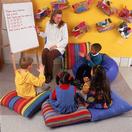The "Talking About Blended Families"
Group

Blended families are the ones formed after one marriage is disolved by divorce or death of a spouse and they remarry, bringing their children to a new family (Kids Health, n.d.).
The number of marriages ending in divorce has grown rapidly in the last several decades. The National Center for Health Statistics reported that about one in every two marriages will result in a divorce (Thompson & Rudolph, 2000). In the past decade, nearly 15 million children were confronted with the experience of divorce, most of them under the age of 8. By 2010, it is expected that over half of school-aged children will be living in what's considered an alternate family structure due to divorce- either a single-parent home or a stepfamily (Sammons & Lewis, 2001). As a result of the divorce rates, blended families are becoming more common. According to Papalia and Olds (1996) 75% of divorced men and 66% of divorced women remarry. A study of family environment in 1999 showed that nearly 7.8% of children in the United States and 8.6% of children in Florida lived in a blended family (1999 Snapshots of America's Families II).
Children of divorce, as referred to by Richardson and Rosen (1999), experience many adverse effects caused by the changes they are dealing with in their lives. DeLucia-Waack (n.d.), stated that "divorce affects children's social, cognitive, and emotional development." The impact of a divorce on a child's life may lead to poor peer relationships, drug dependence, trouble in school, and suicide ideation, among others, (Sammons & Lewis, 2001). Some psychological effects are denial, sense of loss, anxiety, rejection and loneliness (Weinstock & Keen, 2002). The problem increases when children must overcome the obstacles of becoming part of a blended family.
Some of the changes inherent are conflicting loyalty towards one parent while trying to form a relationship with a stepparent, getting along with step-siblings, potential loss of contact with other family members (Kupisch, 1991). Children do not get to choose what happens in their families as far as if their parents divorce and who they remarry. As a result, a sense of powerlessness arises in the child and they feel that they do not have control over their own lives (Seymour, Francis & Steffens, 1995).
For school counselors, it is important to recognize that these problems can also been found in the school-setting. Specific problems may include misbehavior in the classroom, absenteeism, lowered performance levels, and were more likely to be retained in a grade (Richardson & Rosen, 1999).
Group therapy is a helpful tool to use with children of blended families. Research has shown that school-based interventions are effective in addressing and resolving the issues that these children are dealing with (DeLucia-Waack, ; Richardson & Rosen, 1999). A method suggested by Bernstein (2001) takes a psycho-educational approach in which participants can anticipate potential issues or problems and prepare for them.
Our approach was developed for elemetary school-aged children. They are either preparing to become a part of a blended family or are already involved in one and are experiencing the adverse affects of this process. The activities in this program can be used with either the lower (K-2) or higher (3-5) grades of elementary school, using the corresponding adaptations. The intervention will take six weeks, meeting once a week, or three weeks, meeting twice a week. The sessions will take between 30- 40 minutes, depending upon the age of the children and the number of participants. It is recommended that the group consists of 6 to 8 children for optimal results. Each session will begin with an activity to help the group become better acquainted.
The "Talking About Blended Families"
Group

 Session 1: Introduction
Session 1: Introduction
 Session 2: Dealing
with Changes
Session 2: Dealing
with Changes
 Session
3: Talking
About Feelings
Session
3: Talking
About Feelings
 Session
4: Resolving Conflict
Session
4: Resolving Conflict
 Session 5: Making It Better
Session 5: Making It Better
 Session
6: Closing
Session
6: Closing
By Stephanie Arriaza and Stacey
Ritter
February 28, 2002
Department of Counselor Education,
University of Florida